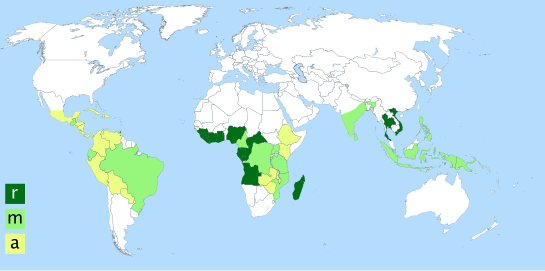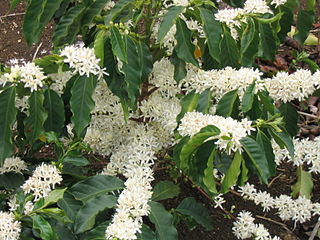
Coffea is a genus of flowering plants in the family Rubiaceae. Coffea species are shrubs or small trees native to tropical and southern Africa and tropical Asia. The seeds of some species, called coffee beans, are used to flavor various beverages and products. The fruits, like the seeds, contain a large amount of caffeine, and have a distinct sweet taste.

Coffee is a beverage brewed from roasted coffee beans. Darkly colored, bitter, and slightly acidic, coffee has a stimulating effect on humans, primarily due to its caffeine content. It has the highest sales in the world market for hot drinks.

Coffea arabica, also known as the Arabica coffee, is a species of flowering plant in the coffee and madder family Rubiaceae. It is believed to be the first species of coffee to have been cultivated and is the dominant cultivar, representing about 60% of global production. Coffee produced from the less acidic, more bitter, and more highly caffeinated robusta bean makes up most of the remaining coffee production. The natural populations of Coffea arabica are restricted to the forests of South Ethiopia and Yemen.
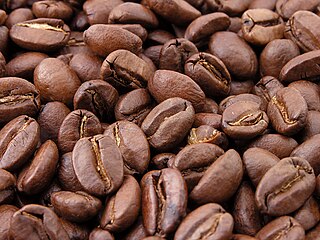
A coffee bean is a seed from the Coffea plant and the source for coffee. It is the pip inside the red or purple fruit. This fruit is often referred to as a coffee cherry, and like the cherry, it is a fruit with a pip. Even though the coffee beans are not technically beans, they are referred to as such because of their resemblance to true beans. The fruits most commonly contain two stones with their flat sides together. A small percentage of cherries contain a single seed, instead of the usual two, called a "peaberry". The peaberry occurs only between 10% and 15% of the time, and it is a fairly common belief that they have more flavour than normal coffee beans. Like Brazil nuts and white rice, coffee beans consist mostly of endosperm.

Illycaffè S.p.A. is an Italian coffee company specializing in espresso, headquartered in Trieste. Illy markets its coffee globally in silver and red pressurized, oxygen-free cans; operates a network of cafes on shopping streets, in museums, and in airports; and, since 2009, has marketed a line of coffee-flavoured energy drinks as illy issimo.
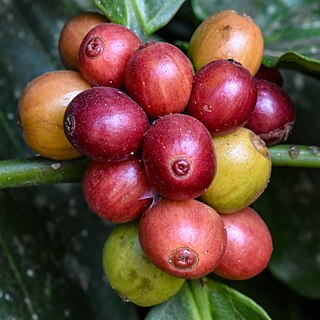
Coffea canephora is a species of coffee plant that has its origins in central and western sub-Saharan Africa. It is a species of flowering plant in the family Rubiaceae. Though widely known as Coffea robusta, the plant is scientifically identified as Coffea canephora, which has two main varieties, robusta and nganda.

The history of coffee dates back to centuries of old oral tradition in modern-day Somalia, Ethiopia and Yemen. It was already known in Mecca in the 15th century. Also, in the 15th century, Sufi monasteries in Yemen employed coffee as an aid to concentration during prayers. Coffee later spread to the Levant in the early 16th century; it caused some controversy on whether it was halal in Ottoman and Mamluk society. Coffee arrived in Italy the second half of the 16th century through commercial Mediterranean trade routes, while Central and Eastern Europeans learned of coffee from the Ottomans. By the mid 17th century, it had reached India and the East Indies.
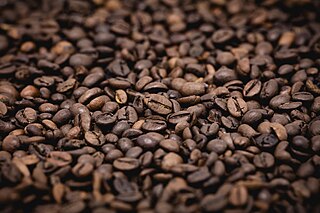
Coffee is a popular beverage and an important commodity. Tens of millions of small producers in developing countries make their living growing coffee. Over 2.25 billion cups of coffee are consumed in the world daily. Over 90 percent of coffee production takes place in developing countries — mainly South America — while consumption happens primarily in industrialized economies. There are 25 million small producers who rely on coffee for a living worldwide. In Brazil, where almost a third of the world's coffee is produced, over five million people are employed in the cultivation and harvesting of over three billion coffee plants; it is a more labor-intensive culture than alternative cultures of the same regions, such as sugar cane or cattle, as its cultivation is not automated, requiring frequent human attention.

Coffea liberica, commonly known as the Liberian coffee, is a species of flowering plant in the family Rubiaceae from which coffee is produced. It is native to western and central Africa, and has become naturalised in areas including Colombia, Venezuela, the Philippines, Borneo and Java.

Coffee production has been a major source of income for Vietnam since the early 20th century. First introduced by the French in 1857, the Vietnamese coffee industry developed through the plantation system, becoming a major economic force in the country. After an interruption during and immediately following the Vietnam War, production rose once again after Đổi mới economic reforms, making coffee second only to rice in value of agricultural products exported from Vietnam.

Indonesia was the fourth-largest producer of coffee in the world in 2014. Coffee cultivation in Indonesia began in the late 1600s and early 1700s, in the early Dutch colonial period, and has played an important part in the growth of the country. Indonesia is geographically and climatologically well-suited for coffee plantations, near the equator and with numerous interior mountainous regions on its main islands, creating well-suited microclimates for the growth and production of coffee.
The Specialty Coffee Association of Indonesia (SCAI) is a trade association that represents stakeholders of Indonesia coffee Industry . The organization was founded in 2007 and as of October 2020 have more than 800 active members. "Excellence in Diversity" is the motto for SCAI, due to the facts Indonesia may have the most variety of coffee in the world and also representing its members that comes from very diverse background but shares same idealism on how to develop Indonesia coffee industry.
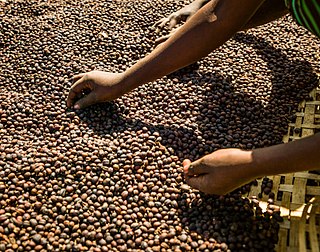
Coffee production in Ethiopia is a longstanding tradition which dates back dozens of centuries. Ethiopia is where Coffea arabica, the coffee plant, originates. The plant is now grown in various parts of the world; Ethiopia itself accounts for around 17% of the global coffee market. Coffee is important to the economy of Ethiopia; around 30-35% of foreign income comes from coffee, with an estimated 15 million of the population relying on some aspect of coffee production for their livelihood. In 2013, coffee exports brought in $300 million, equivalent to 24% of that year's total exports.

Brazil produces about a third of the world's coffee, making the country by far the world's largest producer. Coffee plantations, covering some 27,000 km2 (10,000 sq mi), are mainly located in the southeastern states of Minas Gerais, São Paulo and Paraná where the environment and climate provide ideal growing conditions.

Coffee is Uganda's top-earning export crop. In 1989 Uganda's coffee production capacity exceeded its quota of 2.3 million bags, but export volumes were still diminished by economic and security problems, and large amounts of coffee beans were still being smuggled out of Uganda for sale in neighbouring countries. Uganda is one of the few countries in the world with indigenous coffee, with Robusta coffee growing wild around Lake Victoria.

Thailand is one of the top 25 coffee producers in the world as of 2014, but its status as a coffee origin has not been widely known. Thailand traditionally produced mainly Robusta for industrial use, but the country has quickly become an exciting emerging origin for specialty Arabica and fine Robusta coffees. The origin is unique in that it exports very little coffee and most of the consumption remains in the country. There is a booming specialty coffee ecosystem where farmers, roasters, cafes and consumers symbiotically co-exist. It is often seen as an example of a working coffee ecosystem for an origin where coffee produced is sustainable from both economic and environmental perspectives.
Countries have cultivated coffee beans into various vehicles to satisfy needs unique to each country. Whether it be for energy, socialization, or tradition, the cultivation of coffee has served as a motivating force of the world. The modernization of coffee and its unique forms across cultures are markers of tradition and modern changes across continents. Coffee culture appears in the way in which people consume coffee, the way they make it, and where coffee is served and shared. Each of these factors combined reflects the lives of the people in these countries and the importance of coffee across the world.

Coffea stenophylla, also known as highland coffee or Sierra Leone coffee, is a species of Coffea originating from West Africa.
Benguet coffee, also known as Benguet arabica, is a single-origin coffee varietal grown in the Cordillera highlands of the northern Philippines since the 19th century. It belongs to the species Coffea arabica, of the Typica variety. It is one of the main crops of farmers in the province of Benguet, which has a climate highly suitable for arabica cultivation. Benguet coffee is listed in the Ark of Taste international catalogue of endangered heritage foods by the Slow Food movement.

